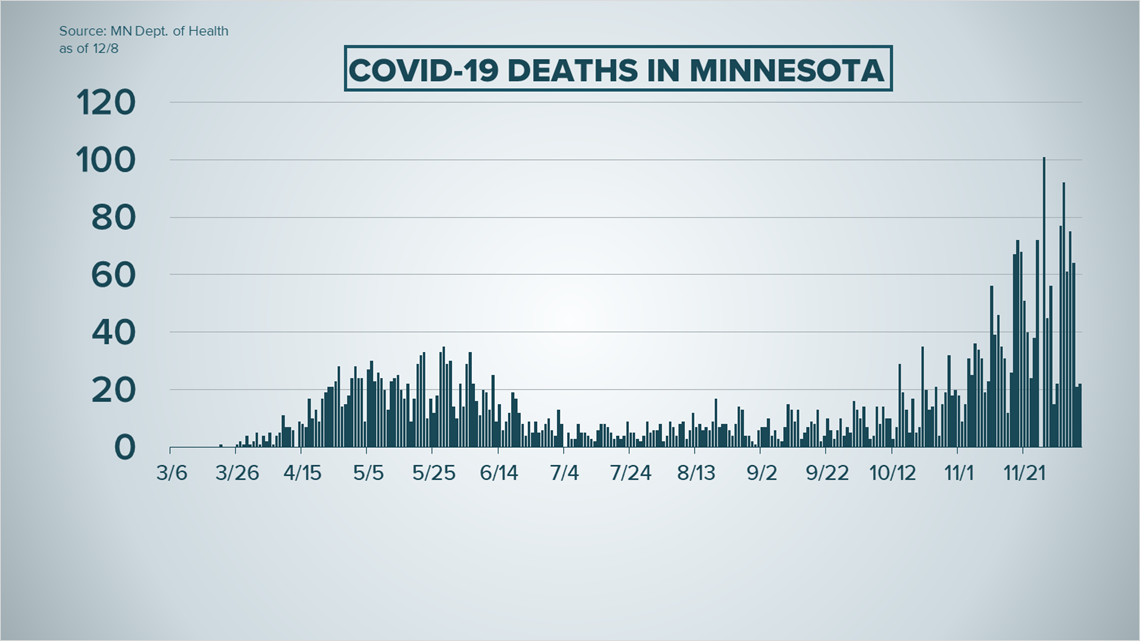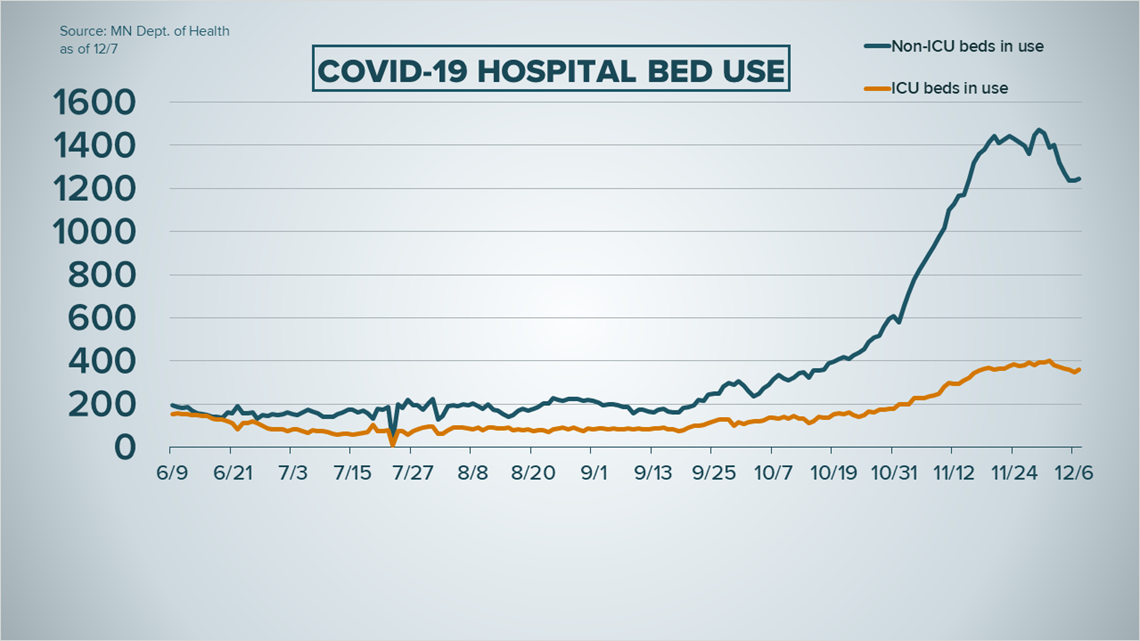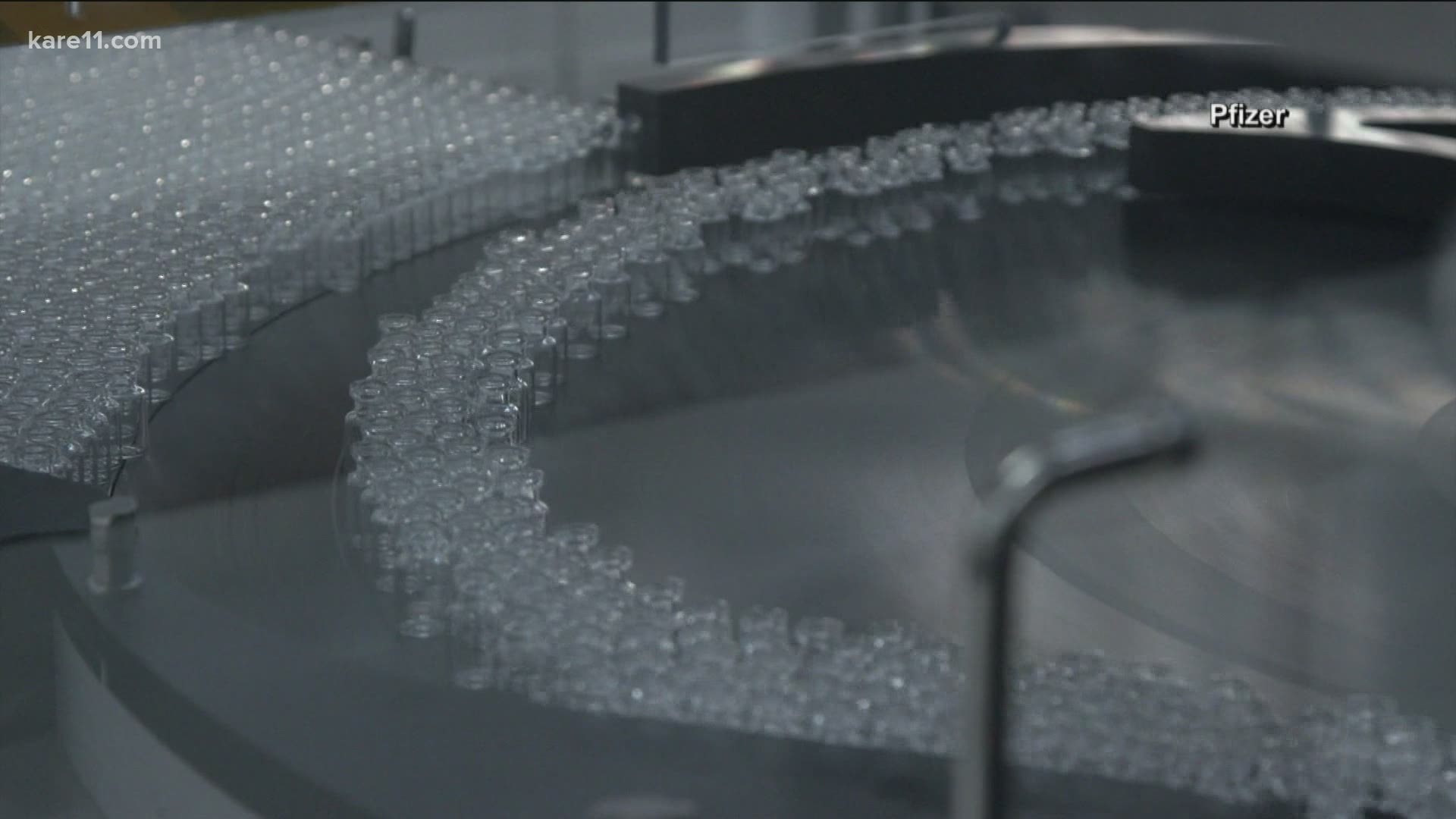ST PAUL, Minn. — Tuesday, Dec. 8
- Minnesota is expecting to receive 183,000 COVID-19 vaccines over the next month
- New cases down significantly, but so is testing
- People will need to receive two doses of the vaccine
- Republican lawmakers propose teachers among first to get COVID-19 vaccine
- Minnesota will shorten quarantine period in line with CDC, still asks anyone who's able to quarantine the full 14 days
- Walz says vaccine prioritization plans will come Tuesday, may have update on "pause" by week's end
2:30 p.m.
Senate Majority Leader Paul Gazelka said the vaccine is not going to be mandated, but that the vaccine does offer the quickest way for life to return back to normal. Gazelka thanked President Trump and Vice President Mike Pence for their work on Operation Warp Speed. Gazelka said he is open to taking the vaccine, but also recently had the virus and says he has antibodies for an unknown period. Gazelka called the vaccine a "lifesaver" for older populations.
MDH Infectious Disease Director Kris Ehresmann said vaccines will begin arriving the week of Dec. 14, and if everything goes according to plan, people can begin getting vaccinated on Dec. 21. People will need two doses that will be given in the interval of around one month.
Ehresmann said people who get vaccinated will receive a card for documentation.
Gov. Tim Walz said the vaccine is a "success story" but infection rates are so high in the country the process of vaccination will take a long time.
1:30 p.m.
Gov. Walz said the state has a solid plan for COVID-19 distribution and the goal is to make it equitable and fair for everyone.
The state aims to partner with federal and local agencies. The federal government is in charge of guaranteeing the safety of the vaccine and local agencies will help get it to Minnesotans, Walz said.
Those who are more susceptible to serious illness and those who care for them will be receiving the vaccine first, Walz said.
Walz urged Minnesotans to not get vaccine information from social media but from reliable sources such as a physician.
Minnesota will be receiving doses from Moderna and Pfizer. The initial supply will be limited but will ramp up as manufacturers can scale production, Walz said.
Walz said 183,000 vaccines are expected to be received over the next four weeks, but the numbers are subject to change.
Both vaccines will require two doses.
MDH Commissioner Jan Malcolm said that while the vaccine distribution is on the horizon, experts are not able to yet say when social distancing and masks will no longer be needed.
MDH Infectious Disease Director Kris Ehresmann said the FDA is expected to give official approval on the Pfizer vaccine on Dec. 10 and the Moderna vaccine on Dec. 17.
It takes around six weeks from getting the vaccine to get protection from COVID-19, Malcolm said.
11 a.m.
New cases of COVID-19 are trending in a positive direction, according to numbers released Tuesday by the Minnesota Department of Health (MDH), but not all markers appear positive.
MDH recorded 3,080 additional cases of the virus in the past 24 hours, more than 2,000 less than the number reported Monday. But testing volume was down as well, making Tuesday's initial positivity rate higher (11.2% vs. 8.1% Monday). Those new cases were based on 27,432 tests (24,743 PCR, 2,689 Antigen) performed in private and state labs in the past day. That volume is less than half of the tests reported Monday.
Health officials regard a positive PCR test as a confirmed case, while a positive Antigen test is considered a probable case.
In all, Minnesota has registered 359,203 cases of coronavirus since the onset of the pandemic. Of those, 8,790 are Antigen-positive cases.
Another 22 Minnesotans have died from the virus, bringing total fatalities to 4,027. Of those deaths 2,660, or 66% are tied to long-term care or assisted living settings.


As of Monday 1,604 hospital beds across the state are currently being used by COVID patients, with 359 of those beds being in the ICU. In the Twin Cities metro, bed availability is down with just 5.4% of ICU beds being open, and 2.9% of non-ICU beds available. The total number of hospitalizations since the start of the pandemic now sits at 18,594, with 4,063 of those patients requiring ICU care.


Young people continue to be the focal point of health officials, as they make up the largest group of cases by a significant margin. Those ages 20 to 24 account for 37,581 cases and two deaths, while people 25 to 29 make up 32,478 cases and four deaths.
The largest grouping of deaths involves those 85 to 89, with 756 fatalities in 4,633 cases.
Hennepin County has the most COVID activity in the state with 75,353 cases and 1,176 deaths, followed by Ramsey County with 31,903 cases and 548 deaths, Dakota County with 25,545 cases ad 218 deaths, and Anoka County with 25,287 cases and 246 deaths.
Cook County in northeastern Minnesota has the least COVID activity with 89 cases and no fatalities, followed by Lake of the Woods County with 123 cases and one death.
10:30 a.m.
Republican state lawmakers are proposing that teachers, school administrators and paraprofessionals be among the first to receive the COVID-19 vaccine in Minnesota.
The suggestion was unveiled by State Rep. Peggy Scott (R-Andover) and State Sen. Michelle Benson (R-Ham Lake) in a virtual news conference on Tuesday morning.
The lawmakers say they agree that hospital staff and nursing home residents should be first in line, but they say educators should be considered next. According to the lawmakers, the focus on educators is due to what they view as negative impacts of distance learning during the pandemic.
Their plan will be introduced at an upcoming special session.
Gov. Tim Walz is set to reveal more about the state's vaccine timeline plan in a 1:30 p.m. news conference.
4 a.m.
Governor Tim Walz confirmed that he and the Minnesota Department of Health (MDH) will announce more details on Minnesota's vaccine rollout plan on Tuesday.
Updates on the state's COVID-19 mitigation efforts surrounding the holidays are expected later this week.
Also Tuesday morning, several Republican Minnesota lawmakers will unveil their proposal to include teachers at the front of the line for the COVID-19 vaccine.
The announcement, hosted by Rep. Peggy Scott and Sen. Michelle Benson, will happen at 9:30 a.m. and include guests involved in the education system.
Monday, Dec. 7
2:30 p.m.
Gov. Tim Walz said at a news conference Monday that he hopes to give an update on the COVID-19 "pause" and any further holiday restrictions by the end of the week.
"We want to give as much lead time as we possibly can," Walz said.
Walz was asked about the restrictions after announcing that Minnesota will follow the CDC in shifting to a 10-day recommended quarantine after exposure to COVID-19, although anyone who is able will still be asked to commit to 14 days.
The governor said that he and the Minnesota Department of Health (MDH) are waiting to see how the Thanksgiving holiday and any increased gatherings from that time will impact hospitalizations and deaths in the next week or so. That impact, he said, will come into decisions about mitigation efforts.
"We're going to start to see numbers be reflective of what happened over Thanksgiving," Walz said. "The lagging number will be hospitalizations versus the cases."
Walz acknowledged that cases and hospitalizations were beginning to plateau before Thanksgiving, but cautioned against drawing a direct causation from the four-week pause.
"The question I think we’re all asking is, will that plateau start to come back up again because of Thanksgiving?" Walz said.
He said at Day 11 after the holiday, those impacts are starting to show up, but it will take longer to see the full picture. However, he acknowledged that Minnesotans want to plan ahead.
"It is our hope to try and provide some guidance around mitigation efforts by the end of this week so that those folks will have a week in advance," he said. "And again, fair enough to say that's really, really hard to adjust your business in that short of amount of time."
Walz said he thinks this week's numbers should provide more guidance because of the length of the incubation period.
“This is the virus’ timeline but people live in the real world," Walz said. “We should start to have a pretty good idea this week."
Walz said that there is no option to "not do anything."
“We’re going to have to mitigate,” he said. "We know that when you don’t do anything it really is the pressure on the hospital situation and then the avoidable deaths that will start to happen."
He said he does not envision the U.S. opening up for the holidays, people flying without masks, and participating in large gatherings.
Walz said there is "every reason" to be optimistic about the vaccine and the light at the end of the tunnel, but that the rollout and impact will take months. "It's not going to happen when the first needle goes in an arm here," he said.
"The hardest weeks, I think, are still ahead of us," Walz said. "The most challenging weeks for our hospitals are still ahead of us."
He also acknowledged that it's the hardest time of the year to be apart from family and friends.
While he would not give an exact date for announcing any further mitigation measures, Walz did confirm that he and MDH will announce more details on Minnesota's vaccine rollout plan on Tuesday.
11 a.m.
New COVID-19 deaths in Minnesota are one-third of those reported Sunday, according to numbers shared Monday by the Minnesota Department of Health (MDH).
An additional 21 people were recorded as dying from the virus over the past 24-hour reporting period, down from the 64 reported Sunday. That brings total fatalities since the onset of the pandemic to 4,005. Of those deaths 2,645, or 66% are tied to long-term care or assisted living settings.
MDH says 5,296 new cases were reported in the last day, bringing the total number of positive cases in the state to 356,152. The new cases were based on the results of 63,573 tests (62,724 PCR, 849 antigen) processed in private and state labs.
A positive PCR test is considered a confirmed case by health officials, while a positive antigen test is considered a probable case.
Currently 1,567 hospital beds across the state are in use by COVID patients, and that number is trending down. Of those beds 362 are in the ICU. Total hospitalizations across the state are now up to 18,358 since the pandemic began, with 4,015 of those patients requiring care in the ICU.
MDH says 314,138 people who at one time tested positive for the virus have recovered enough to no longer require isolation.
Young people between 20 and 24 continue to make up the largest group of cases in Minnesota with 37,265 and two deaths, followed by those 25 to 29 with 32,243 cases and four deaths. The largest group of coronavirus deaths involves people from 85 to 89, with 752 fatalities in 4,595 cases.
Hennepin County reports the most COVID activity with 74,735 cases and 1,170 deaths followed by Ramsey County with 31,551 cases and 545 deaths, Dakota County with 25,282 cases and 217 deaths, and Anoka County with 25,033 cases and 246 fatalities.
Cook County in northeastern Minnesota reports the least COVID activity with 88 cases and zero deaths.
KARE 11’s coverage of the coronavirus is rooted in Facts, not Fear. Visit kare11.com/coronavirus for comprehensive coverage, find out what you need to know about the Midwest specifically, learn more about the symptoms, and see what businesses are open as the state slowly lifts restrictions. Have a question? Text it to us at 763-797-7215. And get the latest coronavirus updates sent right to your inbox every morning. Subscribe to the KARE 11 Sunrise newsletter here. Help local families in need: www.kare11.com/give11.
The state of Minnesota has set up a data portal online at mn.gov/covid19.

